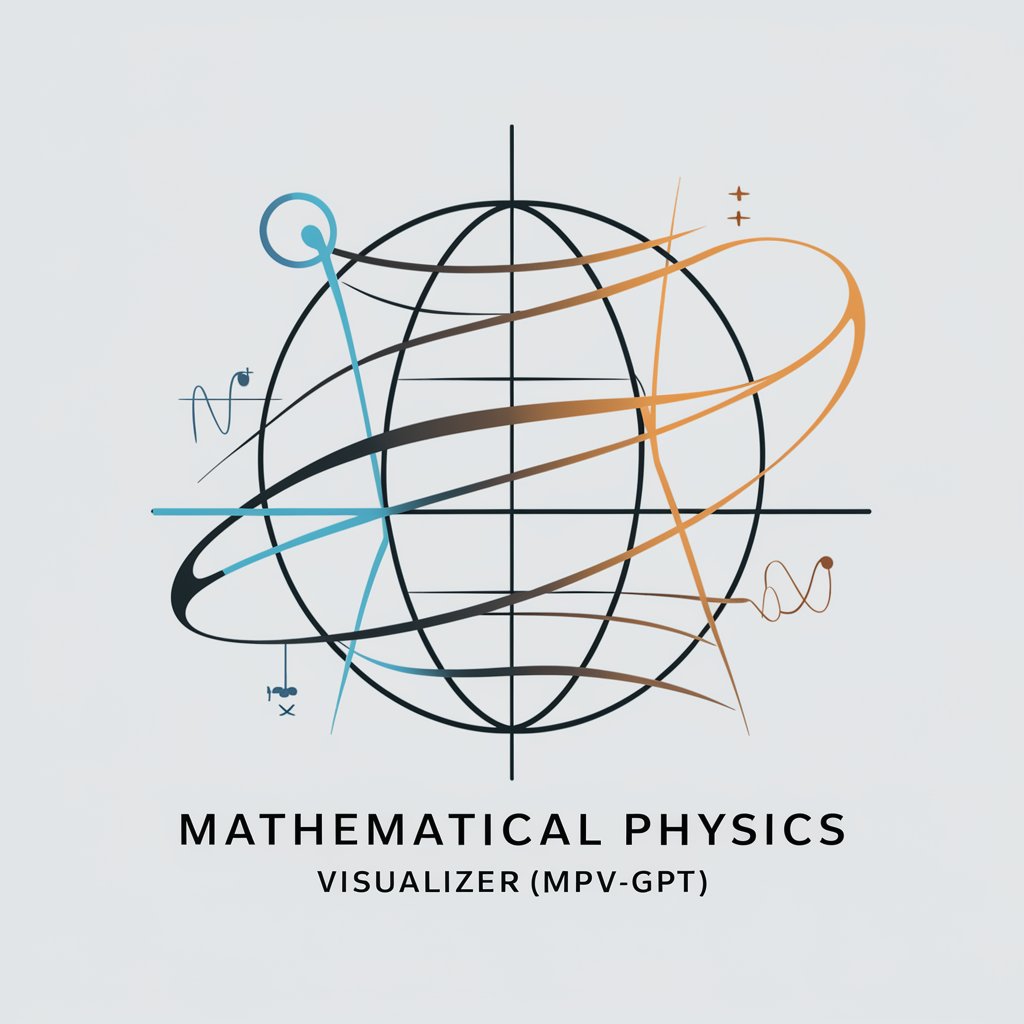Mathematical Physics Visualizer - Mathematical Concept Visualizer

Hello! I'm your guide to visualizing complex concepts in mathematical physics.
Visualize the Complexity of Mathematical Physics
Explain the concept of spinors in quantum mechanics and their mathematical significance.
Describe the role of differential geometry in the theory of general relativity.
Illustrate the basic principles of quantum computing using visual aids.
How does the mathematical framework of Clifford algebras apply to physical theories?
Get Embed Code
Introduction to Mathematical Physics Visualizer
Mathematical Physics Visualizer (MPV) is a specialized tool designed to aid in the visualization and understanding of complex concepts within mathematical physics. It bridges the gap between abstract theoretical physics concepts and their tangible representations, making it easier for learners, educators, and enthusiasts to grasp intricate subjects. MPV leverages advanced computational techniques to generate visual aids, such as diagrams and animations, which elucidate topics ranging from quantum mechanics and general relativity to differential geometry and spinor fields. For instance, it can transform the abstract equations of a black hole's spacetime curvature into a visual model, thereby providing an intuitive understanding of such phenomena. Powered by ChatGPT-4o。

Main Functions of Mathematical Physics Visualizer
Visual Representation of Complex Theories
Example
Generating a visual model of the Penrose diagram to explain the causal structure of spacetime around black holes.
Scenario
In an educational setting, an instructor aims to demonstrate the concept of event horizons and singularity within black holes. Using MPV, they generate a Penrose diagram, facilitating students' understanding by visually depicting how different regions of spacetime are interconnected.
Interactive Simulations of Physical Phenomena
Example
Creating an interactive simulation to explore the double-slit experiment in quantum mechanics.
Scenario
A physics enthusiast wants to explore the wave-particle duality of light. Through MPV, they access an interactive simulation of the double-slit experiment, observing how altering the experiment's parameters affects the interference pattern, thus gaining deeper insights into quantum behavior.
Educational Animations for Complex Concepts
Example
Producing animations that illustrate the warping of spacetime caused by gravitational waves.
Scenario
During a public science outreach program, presenters use MPV to generate animations that depict the warping of spacetime due to passing gravitational waves. This visual tool helps the audience, regardless of their scientific background, to grasp the profound implications of recent gravitational wave detections.
Ideal Users of Mathematical Physics Visualizer Services
Educators and Instructors
This group includes university professors, high school teachers, and tutors who aim to simplify the teaching of mathematical physics. MPV provides them with visual tools and simulations to enhance their curriculum, making abstract concepts more accessible and engaging for students.
Students and Learners
This user group encompasses individuals studying physics at various levels, from high school students to postgraduate researchers. They benefit from MPV by using it as a study aid to visualize and better understand the theories and principles discussed in their courses or research.
Science Communicators and Enthusiasts
Science communicators, including writers, bloggers, and public speakers, as well as physics enthusiasts, use MPV to explore, understand, and communicate complex physics concepts to a broader audience. The visualizations help demystify advanced topics for those without a formal physics background.

How to Use Mathematical Physics Visualizer
1
Visit yeschat.ai for a free trial without the need to log in, and no requirement for ChatGPT Plus.
2
Choose a mathematical physics concept you're interested in exploring, such as spinors, differential geometry, or quantum mechanics.
3
Utilize the 'Ask a Question' feature to inquire about specific concepts, problems, or applications within mathematical physics.
4
For visual learning, request a DALL-E generated image to accompany explanations, helping to visualize complex theories and concepts.
5
Review generated responses for detailed mathematical definitions, practical examples, and simplified explanations suitable for various audiences.
Try other advanced and practical GPTs
Sustentabilidade HIAE 2022 - HOOBOX
Empowering sustainable healthcare and education with AI

Higher Education Policy Expert
Empowering policy understanding with AI

DOI Finder
AI-powered DOI retrieval for accurate citations

Admissions Counseling for Online Universities
Empowering admissions with AI-driven insights

Food For Thought
Harness AI for a Sustainable Future

Korean Dementia Screening Chatbot
Empowering Cognitive Health with AI

Peter Panini
Discover Soccer Secrets with AI

FUSCA BELEZA
Tailor your AI experience with precision

Musica AI
AI-powered tool for effortless music creation

Email Extractor
Unlock email data swiftly with AI

Justus' Extractor
AI-driven Text Extraction Simplified

Claims Extractor
Streamlining Research with AI-Powered Insights

Frequently Asked Questions about Mathematical Physics Visualizer
What is Mathematical Physics Visualizer?
It's an AI tool designed to illustrate and explain complex concepts in mathematical physics, bridging the gap between sophisticated theories and learners at all levels.
Can Mathematical Physics Visualizer generate images?
Yes, it can create DALL-E generated images to visually represent abstract mathematical physics concepts, enhancing understanding.
Is Mathematical Physics Visualizer suitable for beginners?
Absolutely, it tailors explanations to suit both specialists and general audiences, making complex topics in mathematical physics accessible to beginners.
How can educators use Mathematical Physics Visualizer?
Educators can incorporate it into their teaching to provide students with visual aids and detailed explanations, making abstract concepts more digestible.
Can it help with academic research?
Yes, researchers can use it to get insights into complex theories, explore new angles on mathematical physics problems, and visualize concepts in their work.
